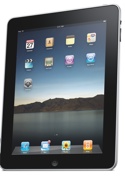The nascent market for media tablets, fostered by the launch of Apple’s iPad, will be driven by the device’s attributes as a content consumption platform and the compelling applications and services that will be created to take advantage of them, according to a new study by International Data Corp. (http://www.idc.com).
According to a the IDC research group, worldwide media tablet shipments will grow from 7.6 million units in 2010 to more than 46 million units in 2014, representing a compound annual growth rate (CAGR) of 57.4%. In comparison, IDC expects 398 million portable computers will be shipped in 2014.
“These are early days for media tablets, an altogether new device category that takes its place between smartphones and portable personal computers,” says Susan Kevorkian, program director, Digital Marketplace: Mobile Media & Entertainment. “IDC expects consumer demand for media tablets to be strongly driven by the number and variety of compatible third-party apps for content and services. The availability of apps unique to media tablets and that differentiate the experience of using one compared with a personal computer or smartphone will be crucial for driving consumer demand. As the category matures and more media tablet-optimized apps become available, IDC expects that media tablets will evolve beyond nice-to-have devices and become necessities for many consumers.”
IDC defines media tablets as tablet form factor devices with 7-12in. color displays. They are currently based on ARM processors and run lightweight operating systems such as Apple’s iPhone OS and Google’s Android OS. This distinguishes them from tablet PCs, which are based on x86 processors and run full PC operating systems.
Media tablets don’t include built-in hardware keyboards but use a stylus/pen or finger for navigation and data input. They provide a broad range of applications and connectivity, differentiating them from primarily single-function devices such as ereaders. Although media tablets will primarily be marketed as multifunction entertainment devices, productivity applications will eventually be available to support consumer and enterprise users, per IDC.




